Introduction
If you’re a dog owner, you’ve probably heard of bag balm. This thick, yellow ointment has been around since the late 1800s and was originally created to soothe and moisturize cows’ udders. But over the years, bag balm has gained popularity among pet owners as a remedy for various skin conditions in dogs. So, you’ve probably thought, “Can you use bag balm on dogs?”. The short answer is yes.
However, before you start slathering your pooch with this multi-purpose balm, there are a few things you should know. In this article, we’ll explore the potential benefits and concerns of using bag balm on dogs.

The Potential Benefits
Discover the benefits of Bag Balm for your dog’s skin. This pet-friendly ointment moisturizes dry or cracked paw pads with its ingredients: petrolatum locks in moisture, lanolin softens skin, and 8-hydroxyquinoline sulfate acts as an antiseptic.
This can be especially helpful during harsh winter months when salt and other chemicals used on roads and sidewalks can irritate your pet’s sensitive paws. Bag balm may also be useful in treating minor cuts, scrapes, or burns.
The antiseptic properties of 8-hydroxyquinoline sulfate can help prevent infection while the moisturizing properties of petrolatum and lanolin can promote healing by keeping the affected area moist. In addition to its skin-soothing properties, some pet owners have found that applying a small amount of bag balm to their dog’s nose can help prevent dryness or cracking caused by exposure to harsh weather conditions.
The Potential Concerns
While bag balm can be a helpful tool in your dog’s grooming kit, there are some potential concerns to keep in mind. One of the main concerns arises from the fact that bag balm lacks formulation for dog usage. While many pet owners have used it with success, it’s always best to check with your veterinarian before trying any new products on your pet.
Another issue to consider is the risk of allergic reaction. Some dogs may be sensitive to one or more of the ingredients in bag balm and may develop an itchy rash or other symptoms after application.
If you notice any signs of an allergic reaction, such as redness, swelling, or discomfort, stop using the product immediately and consult your vet. There is a risk of ingestion if your dog licks the area where you’ve applied bag balm.
While most of the ingredients in bag balm are not toxic, they could still cause digestive upset if ingested in large amounts. Be careful to apply only a small amount and monitor your dog closely after application.
While bag balm can be a useful tool for caring for your furry friend’s skin and paws, it’s important to use it responsibly and with caution. By understanding both its potential benefits and concerns you can make informed decisions about whether or not to add this versatile ointment to your pet-care arsenal.
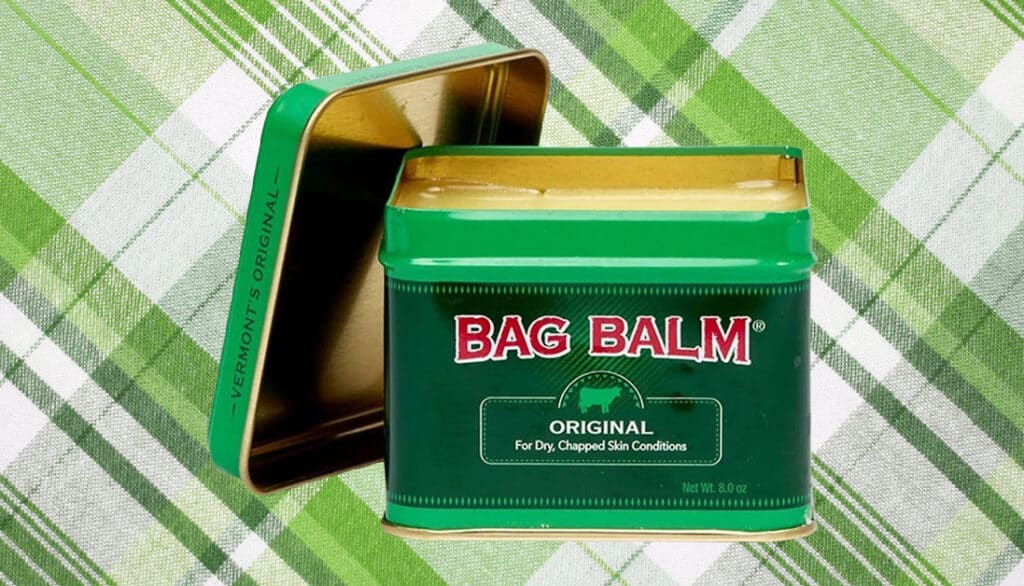
What is Bag Balm?
If you grew up in a farm, or have any experience in taking care of animals, chances are you’ve heard of bag balm. This iconic green tin has been around for over a century, and is widely used as an all-purpose salve for both humans and animals. Bag balm is a thick ointment, typically made with a combination of lanolin, petrolatum, and antiseptic ingredients such as 8-hydroxyquinoline sulfate.
Originally intended to moisturize and soothe cows’ chapped udders in harsh winters, bag balm gained fame among farmers who recognized its healing properties for their hands and other livestock. Today, marketers promote bag balm as a versatile ointment suitable for multiple uses, including moisturizing dry skin and treating minor cuts and burns. As a result, it has become a common household essential, particularly favored by pet owners.
Intended Use
As mentioned earlier, the primary intended use of bag balm was to help heal dry or cracked skin on cows’ udders. The product would be applied to the affected area after milking in order to prevent further irritation or infection. However, over time people started using bag balm for other purposes.
Farmers would use it on their own hands to keep them moisturized and protected from the harsh weather conditions they worked in. Others would apply it to their lips or other dry patches of skin for relief.
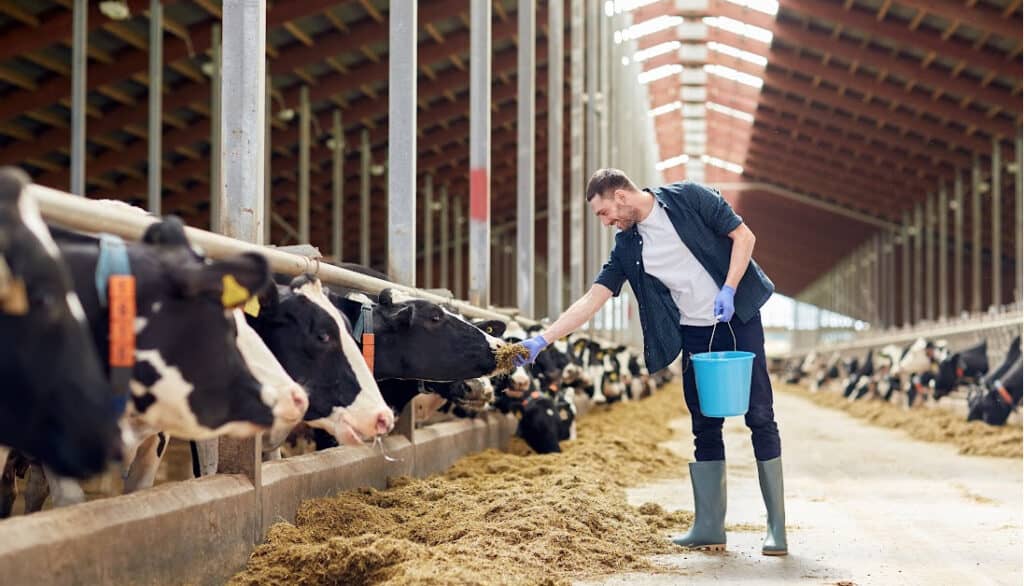
Popularity Among Farmers
Farmers were some of the earliest adopters of bag balm since they had direct contact with cows’ udders on a daily basis. They found that applying the ointment helped prevent chapping during colder months when temperatures dropped significantly.
In addition to preventing chapping on cows’ udders, farmers also started using bag balm on their own hands. The thick, moisturizing formula helped protect their skin from drying out and cracking in the same way it did for cows.
Today, bag balm is still used by farmers and ranchers around the world as a remedy for chapped skin on both animals and humans. It’s considered a classic “old-school” product that has stood the test of time.
Cows Aren’t the Only Ones Who Can Benefit
Although initially intended for cows’ udders, bag balm now serves as a marketed all-purpose salve usable on any mammal, including humans and pets. Many pet owners swear by bag balm when it comes to treating minor skin irritations or dry patches on their furry friends. In fact, some veterinarians even recommend using it to soothe sore paw pads or other mild injuries.
Overall, bag balm has become a household name over the years thanks to its versatility and effectiveness in healing minor skin conditions. Whether you’re dealing with cracked hands in the winter or a scratchy dog nose, this classic ointment may just be what you need to find relief.
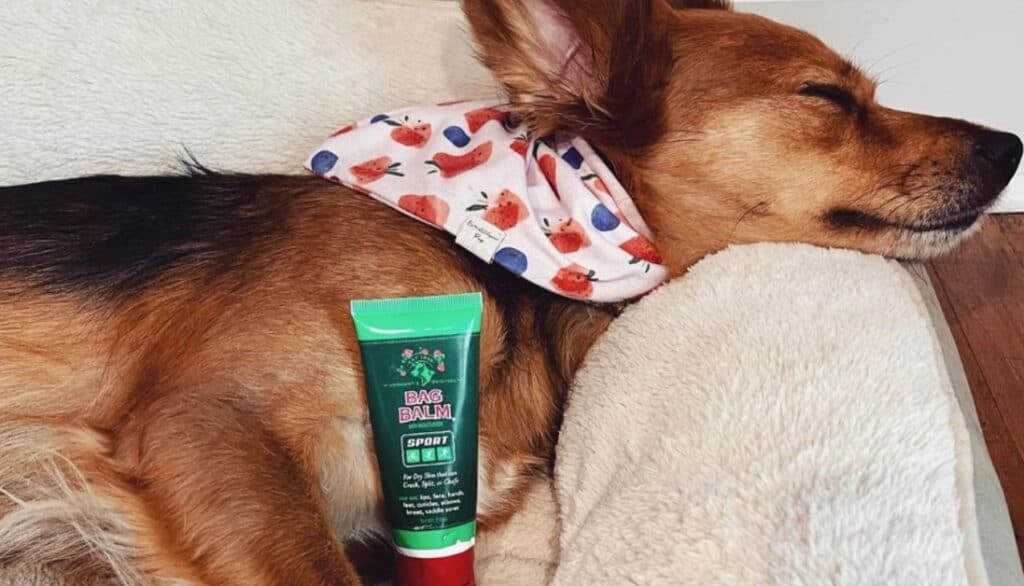
Can You Use Bag Balm on Dogs?
If you’re a pet owner, it’s likely that you’ve heard of bag balm. This multi-purpose ointment is well-known for its ability to soothe dry and irritated skin, making it a popular choice for many people.
But can you use bag balm on dogs? As with most things related to pet care, the answer isn’t cut-and-dried.
While some pet owners swear by using bag balm on their furry friends, others are hesitant to try it. Here’s what you need to know.
Is It Safe to Use Bag Balm on Dogs?
One of the main concerns that pet owners have about using bag balm on dogs is whether or not it’s safe. After all, this product wasn’t specifically formulated for use on animals – it was originally created as a remedy for chapped skin on cows’ udders!
However, while there is no official recommendation from veterinarians about using bag balm on dogs, many pet owners find that it works well for their four-legged friends. When considering whether or not to use bag balm on your dog, keep in mind that some ingredients in the product may be irritating or even toxic if ingested in large quantities.
For example, while petrolatum (the main ingredient in bag balm) is generally considered safe if applied topically, it can be harmful if ingested in large amounts. Additionally, some dogs may be allergic to certain ingredients in the product.
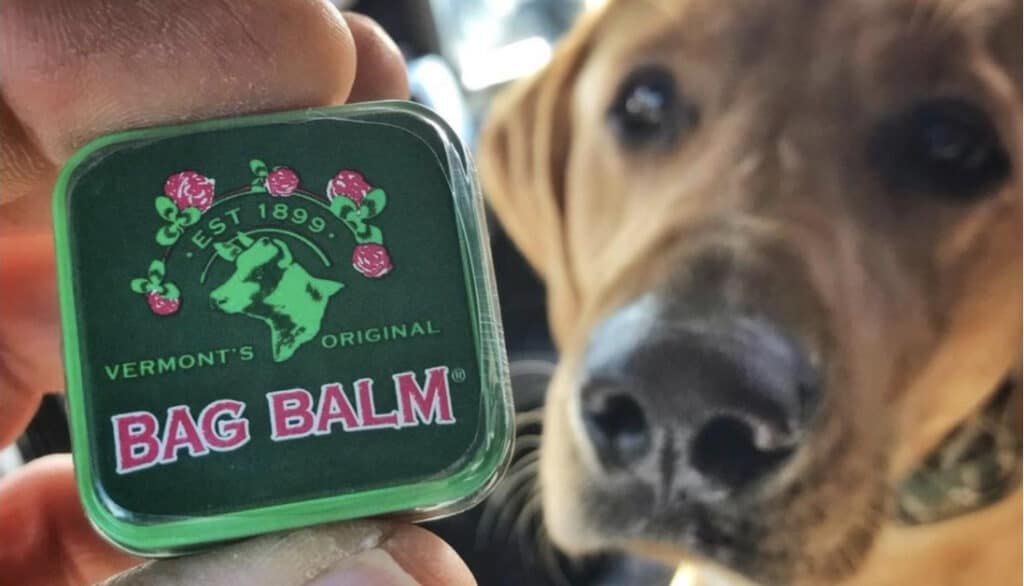
Using Bag Balm as a Remedy for Various Skin Conditions
While there are potential risks associated with using bag balm on dogs (as with any product), many pet owners find that it can be an effective remedy for various skin conditions. For example, if your dog has dry or cracked paw pads due to exposure to harsh weather conditions, applying bag balm can help moisturize and soothe the affected area. Additionally, if your dog has a minor cut or scrape, using bag balm can help to protect the wound and promote healing.
It’s worth noting that there are other products on the market that are specifically formulated for use on dogs’ skin, such as balms and paw protectors. However, many pet owners find that bag balm is a more affordable and accessible option.
How to Use Bag Balm on Your Dog
If you do decide to try using bag balm on your dog, it’s important to apply it correctly in order to minimize any potential risks. Here’s how:
1. Clean the affected area thoroughly with warm water and mild soap.
2. Dry the area completely.
3. Apply a small amount of bag balm to the affected area, rubbing it in gently.
4. Cover the area with a bandage or dressing if necessary (e.g. for cuts or scrapes).
5. Keep an eye on your dog – if they show any signs of itching, redness or irritation after applying the product, discontinue use immediately. Although using bag balm on dogs entails potential risks, as with any product, numerous pet owners discover its effectiveness in treating various skin conditions.
Ultimately, whether or not you decide to use bag balm on your dog will depend on your personal comfort level and your dog’s individual needs and sensitivities. If you’re unsure about whether or not to try using this product, speak with your veterinarian for advice tailored specifically to your furry friend.

Benefits of Using Bag Balm on Dogs
Farmers and pet owners have utilized bag balm for decades as a versatile ointment with multiple applications. While not specifically formulated for dogs, many pet owners have discovered its efficacy in treating diverse skin conditions. Here are some potential benefits of using bag balm on your furry friend:
Moisturizing Dry Skin
If your dog’s skin is dry and flaky, applying a small amount of bag balm can help to moisturize and soothe the affected area. This can be particularly helpful during the harsh winter months when dry indoor heat can exacerbate skin conditions.
When applying bag balm to your dog’s skin, make sure to start with a small amount and rub it in gently. You don’t want to apply too much, as this could cause your dog’s fur to become greasy or attract dirt.
Soothing Minor Cuts and Scrapes
If your dog has a minor cut or scrape, applying a thin layer of bag balm can help to soothe the affected area and promote healing. The ointment contains ingredients like petrolatum and lanolin that help to protect the wound from bacteria while keeping it moist.
It’s important to note that bag balm should not be used on deep cuts or wounds as it could seal in bacteria and prevent proper healing. In these cases, it’s best to seek veterinary care.
Protecting Paw Pads from Harsh Weather Conditions
Dogs who spend a lot of time outdoors may develop dry or cracked paw pads due to exposure to harsh weather conditions like snow and ice. Applying bag balm regularly can help protect your dog’s paw pads from becoming too dry, which can lead to discomfort and even infection.
When applying bag balm to your dog’s paw pads, make sure to rub it in thoroughly and avoid getting it in between their toes. If your dog does lick the area where the ointment was applied, it’s important to monitor them closely for any signs of an allergic reaction or digestive upset.
Treating Skin Irritations
If your dog is experiencing itching, redness, or other skin irritations, bag balm may be able to provide some relief. The ointment’s emollient properties can help to reduce inflammation while keeping the affected area moisturized.
It’s important to note that while bag balm may be helpful for minor skin irritations, it should not be used as a substitute for veterinary care. If your dog is experiencing persistent or severe skin irritations, it’s best to consult with a veterinarian.
Preventing Insect Bites
The petrolatum in bag balm can create a barrier between your dog’s skin and biting insects like fleas and ticks. While this won’t necessarily prevent bites altogether, it can help reduce the number of bites your pet experiences. If you live in an area with a high concentration of biting insects, consider applying a small amount of bag balm around your dog’s ears and neck before going outside.
This can help prevent insects from latching on and causing discomfort. There are many potential benefits of using bag balm on dogs.
Whether you’re looking to moisturize dry skin or soothe minor cuts and scrapes, this versatile ointment may be able to provide some relief. As always, make sure to monitor your pet closely after applying any new product and consult with a veterinarian if you have any concerns about their health.
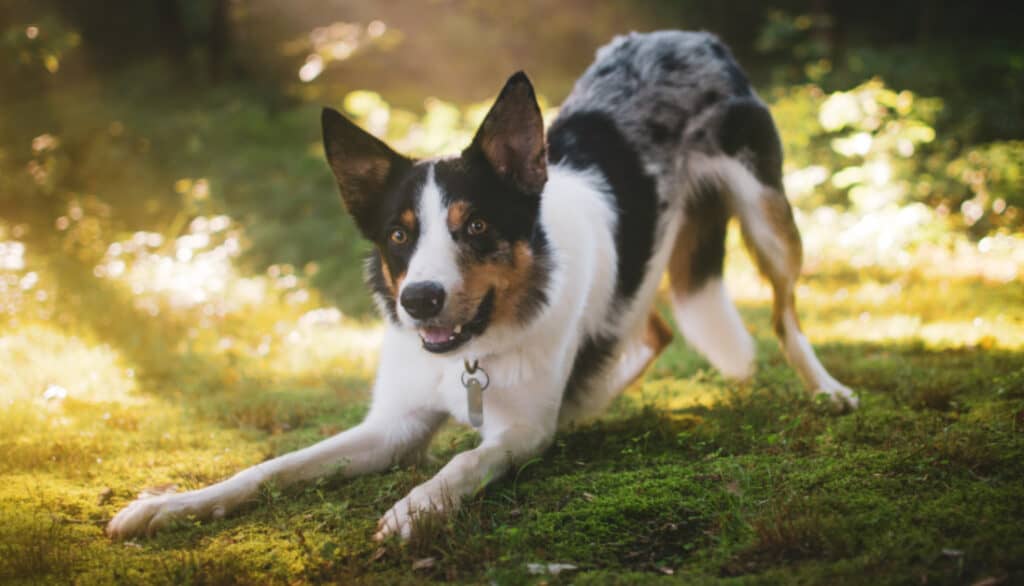
Risks and Concerns
Potential Risks of Using Bag Balm on Dogs
Using bag balm on dogs can offer certain benefits, but it also carries potential risks. One significant risk involves the possibility of dogs developing an allergic reaction to one or more ingredients in the balm.
This can lead to symptoms such as itching, redness, inflammation, and even hives in severe cases. It is important to test a small amount of the product on your dog’s skin before applying it extensively.
Another risk to consider is ingestion if your dog licks the area where you applied bag balm. Consuming the ingredients in this product can lead to stomach upset, vomiting, or diarrhea. It is crucial to prevent dogs from ingesting large amounts of it.
Tips for Minimizing Risks
If you decide to use bag balm on your dog, there are some easy steps you can take to minimize any potential risks:
- Test a small amount: Before applying bag balm all over your dog’s skin, test a small amount on a small patch of skin first. Wait 24 hours to see if there is any adverse reaction before proceeding with further application.
- Apply sparingly: Only apply a thin layer of bag balm to the affected area and avoid putting it near your dog’s mouth or eyes.
- Watch for licking: Keep an eye on your dog after applying the product and prevent them from licking the area where it was applied by using an Elizabethan collar or distracting them with toys or treats.
- Use alternatives: Consider using alternative products specifically formulated for dogs instead of using human-grade products like bag balm. 5. Consult with veterinarian: If you have any concerns about using bag balm on your dog, consult with your veterinarian before trying it out.
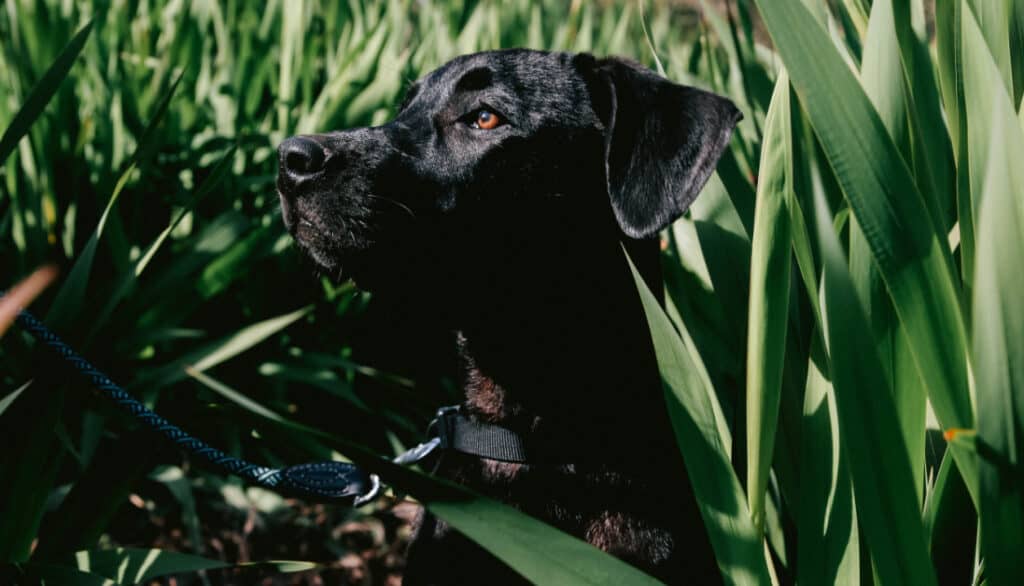
Bottom Line
Using bag balm on dogs can provide some potential benefits, but it also comes with potential risks. It is important to weigh the pros and cons before using it on your furry friend. If you do decide to use it, make sure to follow the recommended precautions and watch for any adverse reactions.
Consider using alternative products specifically formulated for dogs instead of human-grade products like bag balm. Remember, consulting with a veterinarian is always a good idea before trying out any new skin product on your dog.
~ Dr. Candy
